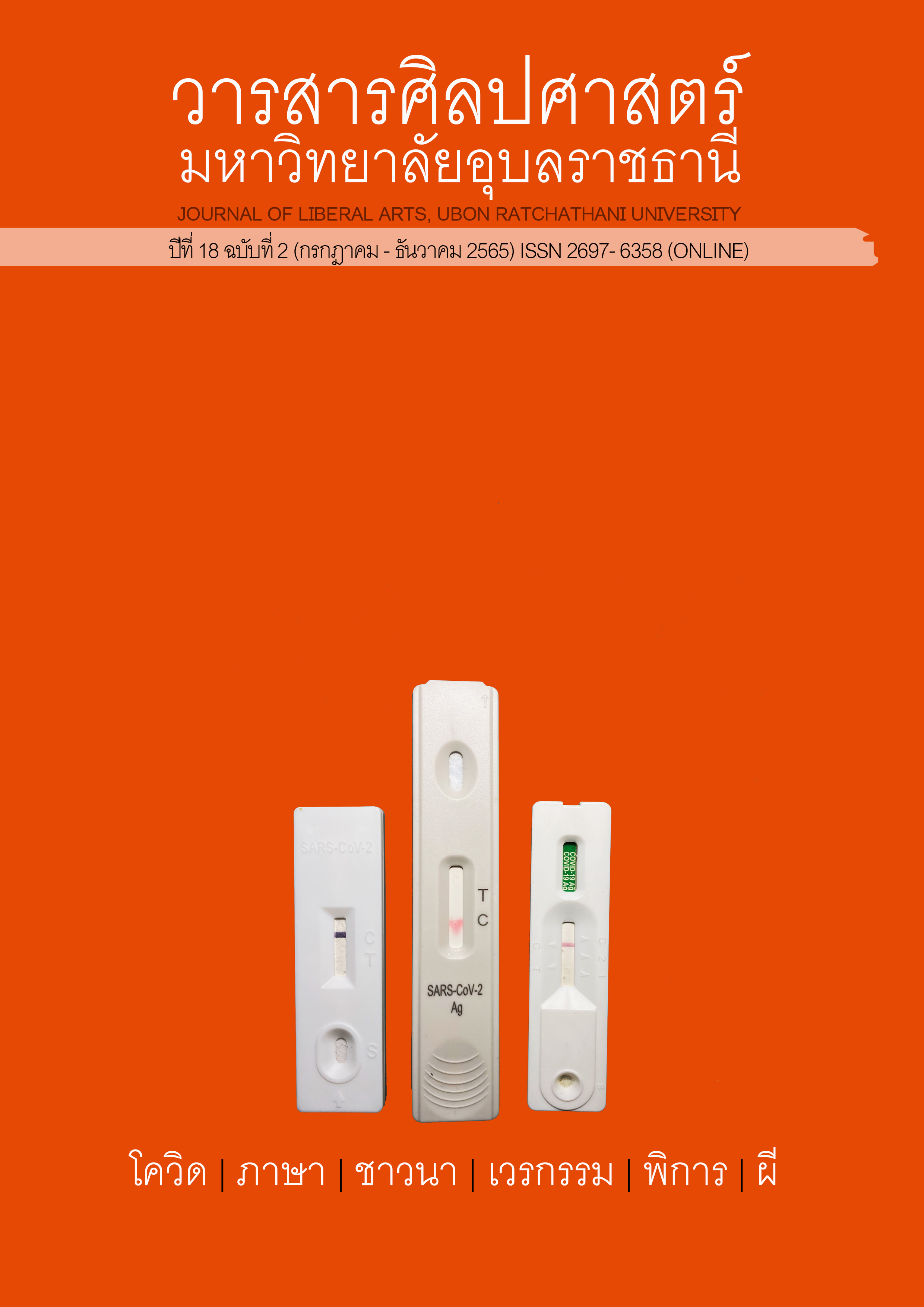การใช้วัฒนธรรมไทโส้ผสานกับสื่อการสอนจริงในการพัฒนาการสอนภาษาอังกฤษสำหรับยุวมัคคุเทศก์
Main Article Content
บทคัดย่อ
งานวิจัยเรื่องการใช้วัฒนธรรมไทโส้ผสานกับสื่อการสอนจริงในการพัฒนาการสอนภาษาอังกฤษสำหรับยุวมัคคุเทศก์ มีวัตถุประสงค์เพื่อพัฒนาภาษาอังกฤษสำหรับยุวมัคคุเทศก์ด้วยวัฒนธรรมไทโส้ผสานกับสื่อการสอนจริงด้านการท่องเที่ยวของโรงเรียนบ้านโพนจาน อำเภอโพนสวรรค์ จังหวัดนครพนม ผู้เข้าร่วมโครงการวิจัยเป็นนักเรียนชาวไทยชาติพันธุ์ไทโส้ อำเภอโพนสวรรค์ จังหวัดนครพนมสามารถพูดภาษาโส้และแวดล้อมด้วยวิถีชีวิตที่เป็นเอกลักษณ์ เครื่องมือที่ใช้ได้แก่ข้อสอบก่อนเรียนและหลังเรียน การสัมภาษณ์แบบปลายเปิดและปลายปิด การสังเกต และการนำเสนอภาษาอังกฤษ การวิเคราะห์ข้อมูลโดยใช้โปรแกรมสำเร็จรูป t-test และการวิเคราะห์ข้อมูลเชิงพรรณนา ผลการวิจัยพบว่า การใช้วัฒนธรรมไทโส้ผสานกับสื่อการสอนจริงด้านการท่องเที่ยวสามารถพัฒนาการสอนภาษาอังกฤษสำหรับยุวมัคคุเทศก์ในท้องถิ่น การส่งเสริมยุวมัคคุเทศก์เป็นประโยชน์ส่งเสริมการท่องเที่ยวในชุมชน นักเรียนสามารถประยุกต์การเรียนรู้ภาษาอังกฤษผ่านวัฒนธรรมไทโส้ผสานสื่อการสอนจริงได้ จากคะแนนก่อนเรียนและหลังเรียนของนักเรียนที่เข้าร่วมโครงการแสดงให้เห็นว่าผู้เรียนสามารถพัฒนาภาษาอังกฤษของตนเองโดยมีค่านัยสำคัญทางสถิติที่ระดับ.01 ผู้เรียนมีโอกาสฝึกภาษาอังกฤษในด้านการเป็นยุวมัคคุเทศก์ในสถานการณ์จริงและควรมีโอกาสได้ฝึกพูดกับชาวต่างขาติมากยิ่งขึ้น
Downloads
Article Details

อนุญาตภายใต้เงื่อนไข Creative Commons Attribution-NonCommercial-NoDerivatives 4.0 International License.
เอกสารอ้างอิง
Bayaci, S, D. & Güner, M. (2018). The Impact of Authentic Material Use in the Development of the Reading Comprehension, Writing Skills, and Motivation in Language Course. International Journal of Instruction, 11 (2), 351-368.
Beresova, J. (2015). Authentic Materials – Enhancing Language Acquisition and Cultural Awareness. Procedia - Social and Behavioral Sciences, 192, 195-204.
Buapromee, N. (2007). The Use of Saengsanam Ceremony Representation for Empowerment Identity and Dignity of Thai So Villagers, Ban Phon Chan, Phon Sawan District, Nakhon Phanom Province. [in Thai]. Master’s Degree of Arts. Chulalongkorn University.
Burns, A. (2017). Research and the Teaching of Speaking in the Second Language Classroom. Handbook of Research in Second Language Teaching and Learning Volume III. London: Routledge.
Center of Preservation of Environment and Local Arts. (2002). The Good Products of Srikotabun, Archaeological Documents, History, Tradition, and Culture of Nakhon Phanom. Center of Nakhon Phanom Culture: Piyamaharacharai School Press.
Dodi, I. (2017). Teaching Vocabulary by Using Realia (Real-Object) Media. English Community Journal, 1 (1), 41-45.
Erdogan, B. (2000, 20 December). Culture in ELT. Research Gate. http://www.researchgate.net/publication/313030902
Harmer, J. (2015). The Practice of English Language Teaching 5th Edition. UK: Pearson.
Hermanan, V. & Amri, Z. (2018). Using Realia to Improve Students Speaking Ability in Junior High School. Journal of English Language Teaching, 7 (1), 106-111.
Jenkins, J. (2006). Current Perspectives on Teaching World Englishes and English as a Lingua Franca. TESOL Quarterly, 40 (1).
Kidwell, T. (2019). Teaching about Culture: The Role of Culture in Second Language Teacher Education Programs. The Electronic Journal for English as a Second Language, 22 (4), 1-16.
Lui, J. (2016). Adaptation of Authentic Materials in English Listening Comprehension Classes. Theory and Practice in Language Studies, 6 (9), 1774-1779.
Mongkoltham, W. (2011). A Study on Potential for Tai-So Ethnic Tourism Development at Ban Pang Daeng, Pang Daeng District, Amphur Dong Luang, Mukdahan Province. E-Proceedings on the Annual Academic Conference on the Development of Thai Future Rural: Stable Base for Sustainable Development. (p. 716-719). 27-29 January, 2011, Khon Kaen, Thailand. Khon Kaen University.
Ni, M, R. et al. (2018). English for Tour Guide: A Need Analysis of a Contextual-Based Language Teaching. The Journal of EDP Sciences, 42 (1), 1-6.
Pho-Klang, K. (2019). A Study of Undergraduate Students Attitudes toward English Authentic Teaching Materials. Liberal Arts Review,
(1), 1-11.
Rachada, P. (2020). Developing English Communication Skills of Local Youth Guides to Increase Tourism Potentials of Ban Pong Manao Archeological Site, Lop Buri Province. Journal of Community Development Research (Humanities and Social Sciences, 12 (3), 1-14.
Ratchamanee, K. (2010). Participatory Action Research for Curriculum Development of Educational an Institution in Additional Course, Entitled: The Local Wisdom of Laiphamudmee Design for Thai So Ban Phon Chan, Nakhon Phanom Province. [in Thai]. Master’s Degree of Education, Mahasarakham University.
Rotchu, P. (2020). The Development of English Reading Comprehension Ability Based on Local Context Reading Materials Scaffolding Technique of Undergraduate Students. Journal of MCU Nakhondhat, 7 (10), 145-166.
Sevillia, F. et al. (2014). Internship Performance of Tourism and Hospitality Students: Inputs to Improve Internship Program. International Journal of Academic Research in Business and Social Sciences, 4 (6), 42-53.
Sumalee, N. & Manorom, A. (2019). Management Museum-based Learning. E-Proceeding 1st International Conference on Recent Innovations of Science and Social Sciences for Sustainability. (p. 228-245). 15-16 July, Kalasin, Thailand. Kalasin University.
Thitthongkam, T. (2017). A study on Blended Learning for Improving English Skills. Journal of BSRU-Research and Development Institute, 2 (1), 12-21.
Tomlinson, B. (1998a). Material Development for Language Teaching. Cambridge: Cambridge University Press.
Will, B. (2011). From Cultural Awareness to Intercultural Awareness: Culture in ELT. ELT Journal, 66 (1), 62-70.
William, G. S. (1993). Outcome-Based Education. Belconnen, A.C.T: Australian Curriculum Studies.


